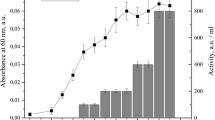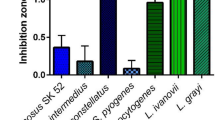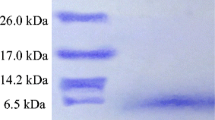Abstract
Mesenterocin 52 (Mes-52), was produced byLeuconostoc mesenteroides ssp.mesenteroides strain FR52 and dextranicin 24 (Dex-24) byLeuconostoc mesenteroides ssp.dextranicum strain J24. Dex-24 had a very narrow spectrum of antibacterial activity: it inhibited only some other strains ofLeuconostoc, contrary to Mes-52, which antagonized alsoListeria andEnterococcus sp. Mes-52 was partially purified by ammonium sulfate precipitation, gel filtration, cation exchange, and hydrophobic interaction chromatography. Mes-52 was biosynthesized and excreted into the medium during growth phase. At different temperatures media, there was an inverse relationship between the final bacteriocin-specific productivity and the mean growth rate. After novobiocin treatment, different mutants of strain FR 52 were obtained: nonproducing-sensitive (Bac−Imm−) and nonproducingimmune (Bac−Imm+) strains. Many changes in the plasmid profiles of several mutants were detected by electrophoresis.
Similar content being viewed by others
Literature Cited
Daba H, Pandian S, Gosselin JF, Simard RE, Huang J, Lacroix C (1991) Detection and activity of a bacteriocin produced byLeuconostoc mesenteroides. Appl Environ Microbiol 57:3450–3455
De Vuyst L, De Poorter G, Vandamme EJ (1989) Nutritional and metabolic regulation of the nisin fermentation process. Med Fac Landbouw. Rijkuniv Gent, 54 (4b):1501–1506
Garvie EI (1986) Gram-positive cocci. GenusLeuconostoc. In: Krieg NR, Holt JG (eds) Bergey's manual of systematic bacteriology, vol. 2. Baltimore: Williams & Wilkins, pp 1071–1075
Harding CD, Shaw BG (1990) Antimicrobial activity ofLeuconostoc gelidum against closely related species andListeria monocytogenes. J Appl Bacteriol 69:648–654
Hastings JW, Stiles ME (1991) Antibiosis ofLeuconostoc gelidum isolated from meat. J Appl Bacteriol 70:127–134
Hastings JW, Sailer M, Johnson K, Roy KL, Vederas JC, Stiles ME (1991) Characterization of Leucocin A-UAL 187 and cloning of the bacteriocin gene fromLeuconostoc gelidum. J Bacteriol 173:7491–7500
Héchard Y, Derijard B, Letellier F, Cenatiempo Y. (1992) Characterization and purification of mesentericin Y105, an anti-Listeria bacteriocin fromLeuconostoc mesenteroides. J Gen Microbiol 138:2725–2731
Klaenhammer TR (1984) A general method for plasmid isolation in Lactobacilli. Curr Microbiol 10:23–28
Klaenhammer TR (1988) Bacteriocins of lactic acid bacteria. Biochimie 70:337–349
Klaenhammer TR (1993) Genetics of bacteriocins produced by lactic acid bacteria. FEMS Microbiol Rev 12:39–86
Lewus CB, Sun S, Montville TJ (1992) Production of an amylase-sensitive bacteriocin by an atypicalLeuconostoc paramesenteroides strain. Appl Environ Microbiol 58:143–149
Mathieu F, Sudirman-Suwandhi I, Rekhif N, Milliere JB, Lefebvre G (1993) Mesenterocin 52, a bacteriocin produced byLeuconostoc mesenteroides ssp.mesenteroides FR52. J Appl Bacteriol 74:372–379
Mayers JA, Sanchez D, Elwell LP, Falkow S (1976) Simple agarose gel electrophoretic method for the identification and characterization of plasmid deoxyribonucleic acid. J Bacteriol 127:1529–1537
Mayr-Harting A, Hedges AJ, Berkeley RCM (1972) Methods for studying bacteriocins. In: Norris JR, Ribbons DWP (eds) Methods in microbiology, vol 7A. New York: Academic Press Inc, pp 315–422
Mørtvedt CI, Nes IF (1990) Plasmid associated bacteriocin production by aLactobacillus sake strain. J Gen Microbiol 136:1601–1607
Nettles CG, Barefoot SF (1993) Biochemical and genetic characteristics of bacteriocins of food-associated lactic acid bacteria. J Food Protect 56:338–356
Piard JC, Deasmazeaud M (1992) Inhibiting factors produced by lactic acid bacteria 2. Bacteriocins and other anti-bacterial substances. Lait 72:113–142
Tagg JR, Dajani AS, Wannamaker LW (1976). Bacteriocins of Gram-positive bacteria. Bacteriol Rev 40:722–756
Van Laack RLJM, Schillinger U, Holzapfel WH (1992) Characterization and partial purification of a bacteriocin produced byLeuconostoc carnosum LA 44A. Int J Food Microbiol 16:183–195
Author information
Authors and Affiliations
Rights and permissions
About this article
Cite this article
Sudirman, I., Mathieu, F., Benoit, V. et al. Properties of two bacteriocins synthesized byLeuconostoc strains. Current Microbiology 28, 155–159 (1994). https://doi.org/10.1007/BF01571057
Issue Date:
DOI: https://doi.org/10.1007/BF01571057




